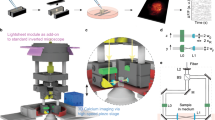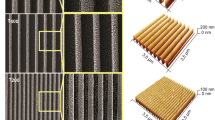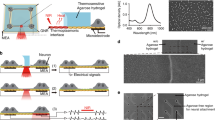Abstract
A central challenge in neuroscience is to understand the formation and function of three-dimensional (3D) neuronal networks. In vitro studies have been mainly limited to measurements of small numbers of neurons connected in two dimensions. Here we demonstrate the use of colloids as moveable supports for neuronal growth, maturation, transfection and manipulation, where the colloids serve as guides for the assembly of controlled 3D, millimeter-sized neuronal networks. Process growth can be guided into layered connectivity with a density similar to what is found in vivo. The colloidal superstructures are optically transparent, enabling remote stimulation and recording of neuronal activity using layer-specific expression of light-activated channels and indicator dyes. The modular approach toward in vitro circuit construction provides a stepping stone for applications ranging from basic neuroscience to neuron-based screening of targeted drugs.
This is a preview of subscription content, access via your institution
Access options
Subscribe to this journal
Receive 12 print issues and online access
$259.00 per year
only $21.58 per issue
Buy this article
- Purchase on Springer Link
- Instant access to full article PDF
Prices may be subject to local taxes which are calculated during checkout




Similar content being viewed by others
References
Beaulieu, C. & Colonnier, M. The number of neurons in the different laminae of the binocular and monocular regions of area 17 in the cat, Canada. J. Comp. Neurol. 217, 337–344 (1983).
Shepherd, G.M. Microcircuits in the nervous system. Sci. Am. 238, 93–103 (1978).
Shepherd, G.M. The synaptic organization of the brain. (Oxford University Press, New York, 1979).
Changeux, J.P. & Dehaene, S. Neuronal models of cognitive functions. Cognition 33, 63–109 (1989).
Golomb, D. & Hansel, D. The number of synaptic inputs and the synchrony of large, sparse neuronal networks. Neural Comput. 12, 1095–1139 (2000).
Ikeda, S.R. Expression of G-protein signaling components in adult mammalian neurons by microinjection. Methods Mol. Biol. 259, 167–181 (2004).
Miyoshi, H., Blomer, U., Takahashi, M., Gage, F.H. & Verma, I.M. Development of a self-inactivating lentivirus vector. J. Virol. 72, 8150–8157 (1998).
Wickersham, I.R., Finke, S., Conzelmann, K.K. & Callaway, E.M. Retrograde neuronal tracing with a deletion-mutant rabies virus. Nat. Methods 4, 47–49 (2007).
Wickersham, I.R. et al. Monosynaptic restriction of transsynaptic tracing from single, genetically targeted neurons. Neuron 53, 639–647 (2007).
Lo, Y.J. & Poo, M.M. Heterosynaptic suppression of developing neuromuscular synapses in culture. J. Neurosci. 14, 4684–4693 (1994).
Wyart, C. et al. Constrained synaptic connectivity in functional mammalian neuronal networks grown on patterned surfaces. J. Neurosci. Methods 117, 123–131 (2002).
Chiappalone, M. et al. Networks of neurons coupled to microelectrode arrays: a neuronal sensory system for pharmacological applications. Biosens. Bioelectron. 18, 627–634 (2003).
Hofmann, F. & Bading, H. Long term recordings with microelectrode arrays: studies of transcription-dependent neuronal plasticity and axonal regeneration. J. Physiol. (Paris) 99, 125–132 (2006).
Morin, F. et al. Constraining the connectivity of neuronal networks cultured on microelectrode arrays with microfluidic techniques: a step towards neuron-based functional chips. Biosens. Bioelectron. 21, 1093–1100 (2006).
Xiang, G. et al. Microelectrode array-based system for neuropharmacological applications with cortical neurons cultured in vitro. Biosens. Bioelectron. 22, 2478–2484 (2007).
Jun, S.B. et al. Low-density neuronal networks cultured using patterned poly-l-lysine on microelectrode arrays. J. Neurosci. Methods 160, 317–326 (2007).
Lee, J., Cuddihy, M.J. & Kotov, N.A. Three-dimensional cell culture matrices: state of the art. Tissue Eng. Part B: Reviews 14, 61–86 (2008).
Schmidt, C.E. & Leach, J.B. Neural tissue engineering: strategies for repair and regeneration. Annu. Rev. Biomed. Eng. 5, 293–347 (2003).
Huang, Y.C. & Huang, Y.Y. Biomaterials and strategies for nerve regeneration. Artif. Organs 30, 514–522 (2006).
Shany, B., Vago, R. & Baranes, D. Growth of primary hippocampal neuronal tissue on an aragonite crystalline biomatrix. Tissue Eng. 11, 585–596 (2005).
Baranes, D. et al. Interconnected network of ganglion-like neural cell spheres formed on hydrozoan skeleton. Tissue Eng. 13, 473 (2007).
Ma, W. et al. CNS stem and progenitor cell differentiation into functional neuronal circuits in three-dimensional collagen gels. Exp. Neurol. 190, 276–288 (2004).
Polleux, F. & Ghosh, A. The slice overlay assay: a versatile tool to study the influence of extracellular signals on neuronal development. Sci. STKE 136, l9 (2002).
Pusey, P.N. & Vanmegen, W. Phase-behavior of concentrated suspensions of nearly hard colloidal spheres. Nature 320, 340–342 (1986).
van Blaaderen, A., Ruel, R. & Wiltzius, P. Template-directed colloidal crystallization. Nature 385, 321–324 (1997).
Letourneau, P.C. Cell-to-substratum adhesion and guidance of axonal elongation. Dev. Biol. 44, 92–101 (1975).
Letourneau, P.C. Possible roles for cell-to-substratum adhesion in neuronal morphogenesis. Dev. Biol. 44, 77–91 (1975).
Abeles, M. Corticonics: Neural Circuits of the Cerebral Cortex. (Cambridge University Press, New York, 1991).
Song, H.J., Ming, G.L. & Poo, M.M. cAMP-induced switching in turning direction of nerve growth cones. Nature 388, 275–279 (1997).
Volgraf, M. et al. Allosteric control of an ionotropic glutamate receptor with an optical switch. Nat. Chem. Biol. 2, 47–52 (2006).
Gorostiza, P. et al. Mechanisms of photoswitch conjugation and light activation of an ionotropic glutamate receptor. Proc. Natl. Acad. Sci. USA 104, 10865–10870 (2007).
Szobota, S. et al. Remote control of neuronal activity with a light-gated glutamate receptor. Neuron 54, 535–545 (2007).
Acknowledgements
We thank E. Callaway (Salk Institute) for the lentiviral DNA constructs (HIV-CS-CG-SynapsinPr-GFP), R. Tsien (University of California, San Diego) for the pRSETB_tdTomato plasmid, K. Kolstad and J. Flannery (University of California, Berkeley) for providing us with the AAV-SynapsinPr-LiGluR virus and for assisting in the preparation of the lentivirus, the Molecular Imaging Center and H. Aaron for help with the confocal microscopy, and M.M. Poo, M. Shelly, M.B. Forstner and S. Kohout for helpful discussions and comments. This work was supported by the US National Institutes of Health Nanomedicine Development Center in Optical Control of Biological Function (PN2 EY1018241). C.W. was supported by a Marie Curie Outgoing International Fellowship funded through Laboratoire de Neurosciences et Systèmes Sensoriels, Centre National de la Recherche Scientifique, Uniteé Mixte de Recherche 5020.
Author information
Authors and Affiliations
Contributions
S.P. designed and executed experiments; C.W. contributed to the light-gated ion channel experiments; and E.Y.I. supervised the project.
Corresponding author
Supplementary information
Supplementary Text and Figures
Supplementary Figures 1–2 (PDF 795 kb)
Supplementary Video 1
Animation of 3D reconstruction of macroscopic 3D neuronal network. Animation showing confocal z-series imaging presented in Figure 2. (MOV 749 kb)
Supplementary Video 2
Animation of 3D reconstruction of neuronal processes on the guiding layer. Reconstruction of axons and dendrites on the 45 μm cAMP beads after 7 days using the filament tracer of the Imaris software (Bitplane Inc.). (MOV 2438 kb)
Rights and permissions
About this article
Cite this article
Pautot, S., Wyart, C. & Isacoff, E. Colloid-guided assembly of oriented 3D neuronal networks. Nat Methods 5, 735–740 (2008). https://doi.org/10.1038/nmeth.1236
Received:
Accepted:
Published:
Issue Date:
DOI: https://doi.org/10.1038/nmeth.1236
This article is cited by
-
Deposition chamber technology as building blocks for a standardized brain-on-chip framework
Microsystems & Nanoengineering (2022)
-
Thermoplasmonic Scaffold Design for the Modulation of Neural Activity in Three-Dimensional Neuronal Cultures
BioChip Journal (2022)
-
3-D multi-electrode arrays detect early spontaneous electrophysiological activity in 3-D neuronal-astrocytic co-cultures
Biomedical Engineering Letters (2020)
-
Reconfigurable engineered motile semiconductor microparticles
Nature Communications (2018)
-
Graphene Improves the Biocompatibility of Polyacrylamide Hydrogels: 3D Polymeric Scaffolds for Neuronal Growth
Scientific Reports (2017)



